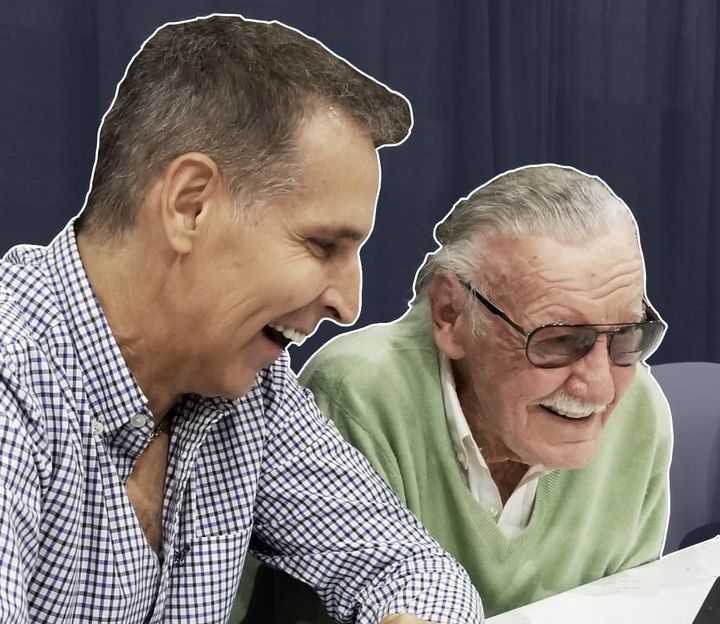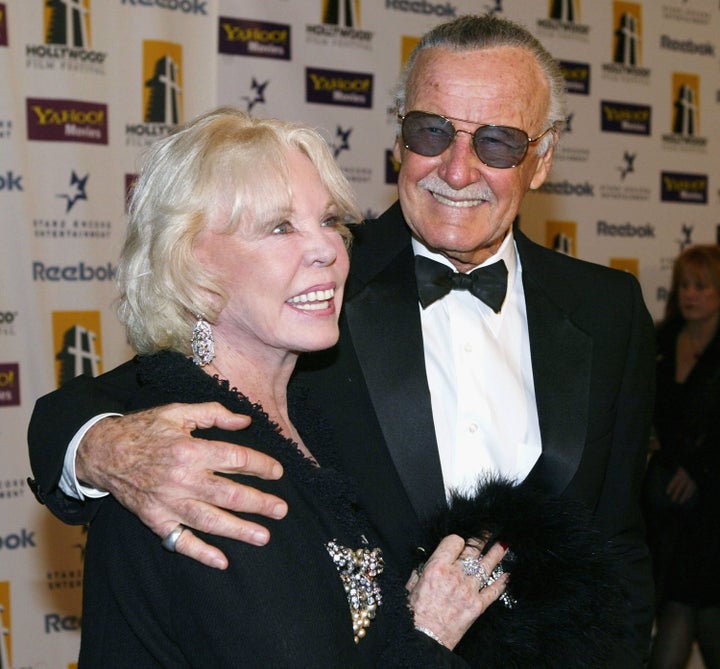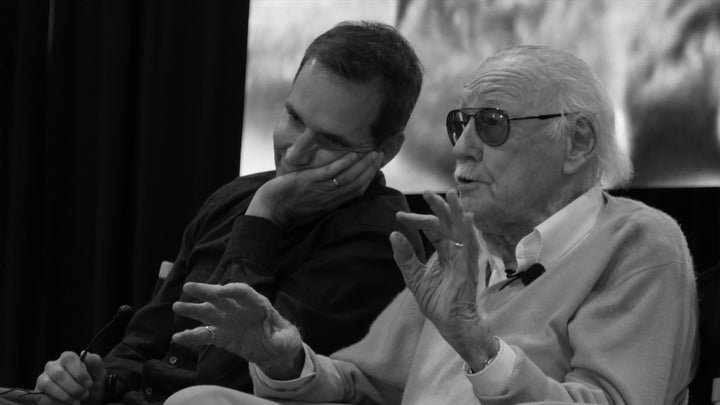
Todd McFarlane’s relationship with Stan Lee began years ago, when the creator of Spawn and co-creator of Venom was just a teen at baseball camp who happened to be staying at a hotel at the same time a comic book convention was taking place.
One of the featured convention guests was Lee.
“To me, Stan Lee, at that point as a 16 year old trying to get into comics, is the pope,” he says. “Because every comic book you buy, his name’s at the top. ‘Stan Lee Presents.’ Every book: Stan Lee, Stan Lee, Stan Lee. And like, oh, my God, here he is. Stan Lee is in front of me. So I wandered on over to him.”
McFarlane says Lee pulled up a chair and he remained there for seven hours while he peppered the comics legend with questions.
McFarlane eventually joined the Marvel ranks in the late 1980s, illustrating for “Incredible Hulk” and “The Amazing Spider-Man.” By that time, Lee had forgotten the interaction with a 16-year-old baseball-playing nerd, but the memory never left McFarlane. He said the day the Marvel boss treated him “like royalty” remains “cemented” in his brain.
“I see the giant that he is, both from a creative point of view and more so from my perspective,” he says. “Just the way he interacts with fans, and the way he treated people and how he was gracious enough to give me seven hours of time when I was 16. He tried to almost do that same thing but condense it to 30-second bites for every person that was in front of him. His level of energy was really astounding, and I think it’s part of the reason why if he started acting like an old man at the end here, we forgot that he was.”

Lee died on Monday at the age of 95. One month before he passed, McFarlane visited the comics veteran, concerned about recent headlines that alleged financial trouble within Lee’s estate. During the visit, one of Lee’s requests regarding his deceased wife, Joan, struck McFarlane.
“A couple times [during my visit] he would say, ‘Todd, I just want to go see Joanie,’” McFarlane says. “Near the end a little bit, he [said], ‘I just want to see Joanie.’ So hopefully ― depending on everybody’s spirituality, whatever people believe ― hopefully he got that wish.”
In an interview with HuffPost, McFarlane talked about his last visit with Lee, providing some insight into the life of a legend that even his most fervent fans might not know.
So what was your visit like with Stan a month ago?
I was up at his house every time I came into LA. I tried to as much as possible, if he was awake or at home, to swing by and say “hi” just for 10 to 20 minutes. He was great at regaling people with stories. He had a thousand stories. That’s one great thing about having a long life: You get great stories. Even when I was on stage with him, he’d tell this story for everyone, and I was deeply entertained. When we were in the car together, he’d tell stories. And then I’d go to his house, it’d be a private setting, and he’d tell stories.
The last time I went to see him, I could tell the tables got turned a little bit. I could see he was tired. The energy wasn’t there, so I said, “Hey, Stan, you know what, you’re always telling me stories. Let me tell you a bunch of crazy stories about my life and my wife and my career a little bit, and I can sort of lighten your load here for an hour.” One thing that’s not attractive about turning 95 is the body has a tendency to betray you a little bit. His eyesight was getting really bad and his hearing, so it was a frustration to him, especially with the loss of his wife a year earlier. “I can’t enjoy life. I can’t even see it. And, oh, by the way, even if I want to enjoy it, my wife isn’t here anymore.” But I’m guessing that’s not a whole unique thing for people who get to live as long as he does.
I also know people who think that what he did was a shtick. Because it was so high energy, you go, ah, he just puts on this sort of act here. I would get off the airplane sometimes and he’d meet me and we’d share the cab ride where we were going, and he’d just go — I’ve got recordings of him — just poking fun and telling jokes [with] me being the butt of his stories. Like, “I don’t understand why you’re here. I’m the more handsome of the two. This is gonna be such a terrible panel with you on it,” and blah blah blah. Some of it I’d heard before, but like I said, I marvel. I’ve got a father who still has a lot of energy, so I marvel at people who still see the glass of the world as half-full.
With the headlines that we’ve seen about his estate, what was it like visiting him?
Besides being a dear friend, the other agenda was to just make sure that this elderly man was good, right? My father’s still alive, so I was probably projecting because, again, you’re in the business here. You read all the stories. Where does fact and fiction start? I was in the middle of all that, so maybe someday I’ll tell my story, but I just go, I gotta keep going to see to make sure when different people were around him that he was at least being treated with the reverence that a 90-year-old man should have. Just common decency. I just was hoping he was comfortable with common decency. That’s all.
All the rest of it, that he was Stan Lee and all the other stuff, was a little secondary to me. I wish it wasn’t there. I wish he would’ve gone out going, “I had a beautiful wife of 70 years and I left on top.” And there wasn’t this little cloud that had spun around him for the last year or so. But Todd only rhymes with God.
What’s it like looking back on his legacy?
In comic books, he’s at the top. He’s at the top for two reasons. You can go vertical, and the vertical is how many characters and ideas you created, and then you start stacking them on top of each other. So he created this giant column of hype that some of us will just pretend to go to our grave having done a fraction of what he did. That in and of itself is almost unparalleled. Then you start going horizontal, and the spread of those characters globally ― especially in the last 10 to 20 years with the movies that he created, this vast array of characters ― they got spread across an entire planet. Who does that?
You start getting into those categories, you start counting those creative people on fingers that have that kind of impact. I’m talking about in every country in the world. From a strictly creative point of view, the only other one I can think of remotely in that category is Walt Disney. He built an empire, too, and spread it across the nation. I have to believe the goal of any creative person is you create something that will ultimately outlive you, which means it was relevant and important to enough people’s lives. Disney did it, and we’re now decades past his passing. Obviously, we’re going to see that Stan Lee had a giant impact just like that, if not grander.
What’s something fans might not realize about Stan Lee or fully appreciate?
In talking to him, that he was just as nervous about his creations and whether his ideas were good enough as all the rest of us. All those same doubts that permeate any amateur or any professional person that just goes, “Am I doing it, right?” We now have hindsight to say they did and it worked, but when he was talking to me about when he was creating those ― he didn’t know that he was about to unleash some unparalleled creativity in front of us. He thought some of it might fail miserably. I think it’s a lesson to be taught to everybody that even the greats don’t know when they’re being great. He was just as fallible at the beginning of all this as we were, and he’d be the first to admit that he had a lot of good luck on his side and things sort of went his way. I’m sure if he could’ve waved a wand and shared it with a lot of people he would’ve.

Were there characters he thought weren’t going to pan out? Like, did he ever say, “I didn’t know about Spider-Man.”
Let’s take Spider-Man. Spider-Man went into a comic book called “Amazing Fantasy,” and the reason was because they were basically going to get rid of the book. Because it was floundering. So they said, “Hey, come up with something and maybe the book might rebound or we could keep it going for a couple more months.” Maybe he’d been thinking about it for a long time. Maybe he goes, “Hey, cool name.”
But it could’ve easily been the last issue of “Amazing Fantasy,” and that was the end of that character. But with Jack Kirby showing this cool costume, and later Steve Ditko giving us the artwork, it ends up having the opposite effect. Oh, my gosh, we can’t cancel this book. We’re going to have to keep this character going, but ... let’s turn the book from “Amazing Fantasy” into “Amazing Spider-Man.” And from there, given that “Fantastic Four” had just come out, that basically was the foundation Marvel was built on ― those two early ideas.
Wow, that is amazing.
I don’t think people sort of understand the history of what was happening with comic books. We were coming from the war zone Senate hearings of, “Comic books were bad for society.” He was tasked with trying to come up with something that was more pure Americana, if you will. The Comics Code [Authority] comes in, so he was trying to do a little more lighthearted stuff, which is why Peter Parker is a little goofy. Even the Thing ... he played with a lot of levity in it.
He also knew that when you got those components that you have to have a big opposing villain to have the hero seem that much more inspiring. When you talk to him about it, it’s almost like an architect telling you how he’s going to put a building together. Then you hope that it holds in the bad weather. He just kept pumping them out and he kept doing it.
I asked him before ... there’s a reason why a lot of his characters have names that start with the first and last letter: Peter Parker, Doc Doom, Reed Richards, Sue Storm, Bruce Banner. Part of it was he was doing so much work and his memory wasn’t that good. He said back then that, “It’s like I had to find a cheat to remember all these characters. I was creating at such a fast pace.” When he was in the middle of it, he would go, “I don’t know what’s going to stick here. So I have to figure out these shortcuts in the creative process so that it all sort of works. I hope that some of it sticks.” And the vast majority of it did.
He was attached to some brilliant artists at that time too that helped give visual to the stories you put down. I think he’d be the first to admit that he tripped into a lot of good fortune. Maybe that’s why he loved the fans so much, because he knew if they didn’t like what he was doing, he’d have no career. He was thankful they gave him a career.
